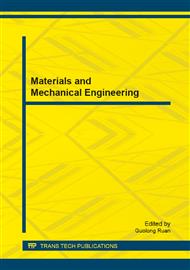[1]
X. Tong, et al. Thermal fatigue resistance of H13 steel treated by selective laser surface melting and CrNi alloying, Appl. Surf. Sci., (2013), http: /dx. doi. org/10. 1016/j. apsusc. 2013. 01. 209.
DOI: 10.1016/j.apsusc.2013.01.209
Google Scholar
[2]
J.Z. Lu, K.Y. Luo, D.K. Yang, X.N. Cheng, J.L. Hu, F.Z. Dai, H. Qi, L. Zhang, J.S. Zhong, Q.W. Wang, Y.K. Zhang, Effects of laser peening on stress corrosion cracking (SCC) of ANSI 304 austenitic stainless steel, Corros. Sci., 2012, 60, 145-152.
DOI: 10.1016/j.corsci.2012.03.044
Google Scholar
[3]
H. Amar, V. Vignal, H. Krawiec, C. Josse, P. Peyre, S.N. da Silva, L.F. Dick, Influence of the microstructure and laser shock processing (LSP) on the corrosion behaviour of the AA2050-T8 aluminium alloy, Corros. Sci., 2011, 53, 3215-3221.
DOI: 10.1016/j.corsci.2011.05.066
Google Scholar
[4]
M. Morales, J.A. Porro, M. Blasco, C. Molpeceres, J.L. Ocana, Numerical simulation of plasma dynamics in laser shock processing experiments. Appl. Surf. Sci., 2009, 255, 5181-5185.
DOI: 10.1016/j.apsusc.2008.09.067
Google Scholar
[5]
Hyuntaeck Lim, Pilkyu Kim, Hoemin Jeong, Sungho Jeong, Enhancement of abrasion and corrosion resistance of duplex stainless steel by laser shock peening, J. Mater. Process. Tech., 2012, 212, 1347-1354.
DOI: 10.1016/j.jmatprotec.2012.01.023
Google Scholar
[6]
L. Zhang, J.Z. Lu, Y.K. Zhang, K.Y. Luo, J.W. Zhong, C.Y. Cui, D.J. Kong, H.B. Guan, X.M. Qian, Effects of different shocked paths on fatigue property of 7050–T7451 aluminum alloy during two-sided laser shock processing', Mater. Des., 2011, 32, 480-486.
DOI: 10.1016/j.matdes.2010.08.039
Google Scholar
[7]
Igor Altenberger, Ravi K. Nalla, Yuji Sano, Lothar Wagner , Robert O. Ritchie, On the effect of deep-rolling and laser-peening on the stress-controlled low- and high-cycle fatigue behavior of Ti-6Al-4V at elevated temperatures up to 550℃, Int. J. Fatigue, 2012, 44, 292-302.
DOI: 10.1016/j.ijfatigue.2012.03.008
Google Scholar
[8]
Myriam Gharbi, Patrice Peyre, Cyril Gorny, Muriel Carin, Simon Morville, Philippe Le Masson, Denis Carron, Rémy Fabbro, Influence of various process conditions on surface finishes induced by the direct metal deposition laser technique on a Ti–6Al–4V alloy, J. Mater. Process. Tech., 2013, 213, 791-800.
DOI: 10.1016/j.jmatprotec.2012.11.015
Google Scholar
[9]
Y.K. Zhang, J. You, J.Z. Lu, C.Y. Cui, Y.F. Jiang, X.D. Ren, Effects of laser shock processing on stress corrosion cracking susceptibility of AZ31B magnesium alloy, Surf. Coat. Technol., 2010, 204, 3947-3953.
DOI: 10.1016/j.surfcoat.2010.03.015
Google Scholar
[10]
X.C. Zhang, Y.K. Zhang, J.Z. Lu, F.Z. Xuan, Z.D. Wang, S.T. Tu, Improvement of fatigue life of Ti–6Al–4V alloy by laser shock peening, Mater. Sci. Eng., 2010, A527, 3411-3415.
DOI: 10.1016/j.msea.2010.01.076
Google Scholar
[11]
P. Peyre, C. Carboni, P. Forget, G. Beranger, C. Lemaitre, D. Stuart, Influence of thermal and mechanical surface modifications induced by laser shock processing on the initiation of corrosion pits in 316L stainless steel, J. Mater. Sci., 2007, 42, 6866-6877.
DOI: 10.1007/s10853-007-1502-4
Google Scholar
[12]
Y.K. Zhang, Y.Y. Gu, X.Q. Zhang, J.G. Shi, J. Zhou, Study of the mechanism of overlays acting on laser shock waves, J. Appl. Phys. 100 (2006) 103517-1–103517-6.
DOI: 10.1063/1.2364037
Google Scholar
[13]
Liucheng Zhou, Yinghong Li, Weifeng He, Guangyu He, Xiangfan Nie, Donglin Chen, Zhilin Lai, Zhibin An, Deforming TC6 Titanium alloys at ultrahigh strain rates during multiple laser shock peening, Mat. Sci. Eng. A-Struct., ht tp : /dx. doi. org/10. 1016/j. msea. 2013. 04. 070.
DOI: 10.1016/j.msea.2013.04.070
Google Scholar
[14]
H.X. Liu, Y. Hu, X. Wang, Z.B. Shen, P. Li, C.X. Gu, H. Liu, D.Z. Du, C. Guo, Grain refinement progress of pure titanium during laser shock forming (LSF) and mechanical property characterizations with nanoindentation, Mat. Sci. Eng. A-Struct., 2013, 564, 13–21.
DOI: 10.1016/j.msea.2012.11.087
Google Scholar


